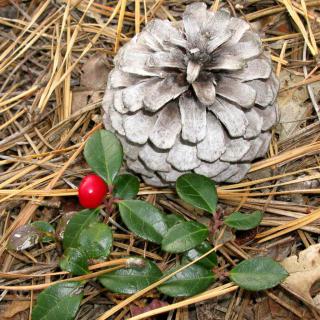

American wintergreen is a nice evergreen shrub that hosts shiny red berries in winter that are full of medicinal benefits.
Name – Gaultheria procumbens
Family – Ericaceae
Type – shrub
Height – 6 to 8 inches (15 to 20 cm)
Exposure – part sun
Soil – heath soil
Foliage – evergreen
Flowering – April-May
American wintergreen or Gaultheria procumbens (and, more rarely, Pernettya) is a small sub-shrub, cousin to heather and blueberries that also belong to the Ericaceae family.
American wintergreen grows in Canada and in Northeast United States. Its leaves are oval, leathery, and when they are wounded a strong medicinal fragrance spreads, similar to that of meadowsweet.
The small white American wintergreen flowers produce sweet, tasty bright red berries.
American wintergreen is best planted in fall, but it is still perfectly possible to plant them in spring if you have purchased your plants in containers from the nursery.
American wintergreen particularly appreciates acidic soil and will thrive in heath soil.
This shrub is perfectly suited to being grown in pots for your terraces and balconies. It is also fine for heath soil shrub beds or as a stand-alone.
The need for acidic well-drained soil and shade means American wintergreen shares the same growing conditions as heath plants like azalea, hydrangea, camellia, heather or rhododendron.
American wintergreen is easy to care for and only requires very little care.
Water regularly during extended dry spells, especially potted American wintergreen.
This slow-growing round-shaped shrub bears beautiful spring blooms that are particularly fragrant and reminisce of orange flowers.
But it is mostly known for its red berries that are produced in fall and stay on the shrub all winter long, and harbor a boon of medicinal properties.
Indeed, the blooming is followed by cute red fruits that keep American wintergreen brightly colored from spring to winter.
Additionally, the fragrant evergreen leafage will let you appreciate it even more on your terrace or balcony.

or muscle contractions such as low back pain.
Its virtues are appreciated and praised by all who have suffered muscle and joint pain and who have found relief thanks to it.
American wintergreen, thanks to the analgesic properties of methyl salicylate, reduces pain and consequently enhances muscle tone.
It is massaged around the painful are, diluted for example with Arnica oil or any other plant-based oil.
The red berries – white in the inside – are edible. When raw, they strongly taste of methyl salicylate.
If you are allergic to aspirin, do not ingest American wintergreen.
Indians were avid users of American wintergreen to soothe back pain, migraines (headaches), rheumatism, fevers and also colds.
Avoid planting them in flood-prone areas because they like well-drained soil.
Credits for images shared to Nature & Garden (all edits by Gaspard Lorthiois):
Frost on Gaultheria procumbens by Irene Wirsing under Pixabay license
American wintergreen seedling by Sandra Richard under © CC BY-NC 2.0